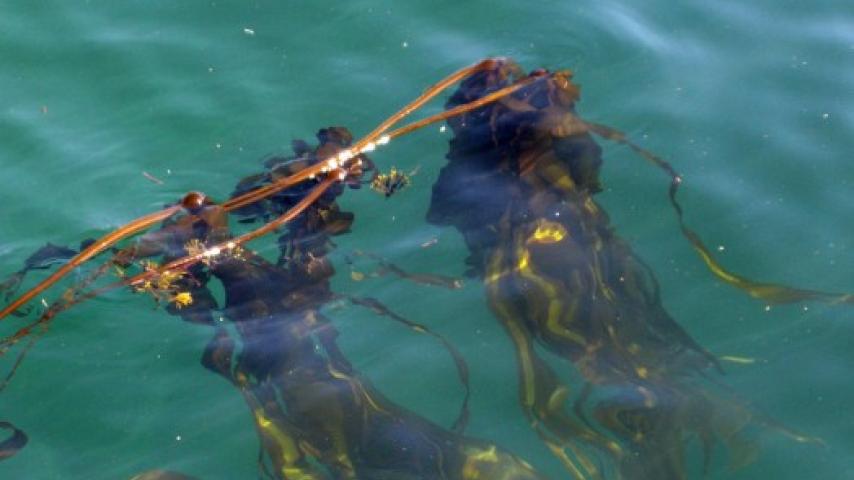Bull Kelp (Nereocytis luetkeana)
“Kelp” is a term used for several kinds of brown algae, mostly very large ones. The most common kind, and the largest, in Puget Sound is Bull Kelp.

KINGDOM Chromalveolata - PHYLUM Heterokontophyta - CLASS Phaeophyceae - ORDER Laminariales - FAMILY Laminariaceae
Bull Kelp is easily recognized by its very long stipe (stalk), up to 30 meters or more in length, extending from the holdfast that attaches it to the bottom to a floating hollow bulb that may be over 10 centimeters in diameter. Long, leaflike blades up to three meters in length branch from the bulb and spread out to float on the surface. These blades provide the plant with both photosynthesis and nutrient absorption. The hollow upper part of the stalk is also filled with gas (including carbon monoxide!), so the stalks float in long snaky rows at lower tides.
The most amazing thing about the large kelps is that they grow to this size in one season, surely the fastest growth rate of any large organism. The stipes can grow up to five inches per day in optimal conditions of nutrients and light. Because the holdfast grows anew each season, it is not as large or tenacious as the holdfasts of perennial kelps, and in rough weather, entire plants may be pulled loose. Drifting Bull Kelp may be seen far out at sea.
After a summer of growth, the plants begin to decay and die off during winter. They are made of tough material, however, and it takes a long time for a kelp to decay completely, so they float in and lie on beaches for months, furnishing habitat for amphipods and other little intertidal and supratidal creatures.
Kelp stalks are amazingly flexible, and they can stretch as much as a third of their length without breaking. This flexibility allows them to flourish in areas where they are pulled back and forth with high tidal exchange.
Kelp show typical algal reproduction, with alternation of generations. The large plants are sporophytes and produce spores along the blades in sori comparable to fern sori. They shed the spores in summer and fall, and these grow into the tiny, filamentous gametophytes, the sexual generation. These gametophytes shed sperm and eggs in winter and early spring, and when fertilized, the eggs develop into the familiar sporophytes.
A well-established Bull Kelp community is like an old-growth forest in that the large kelps shade out the “understory” enough so that new plants do not have high enough light levels to grow and photosynthesize.


